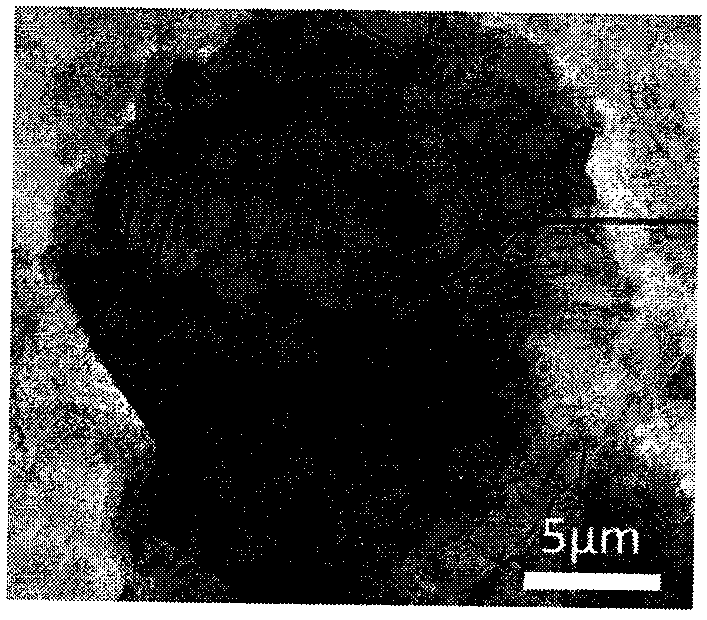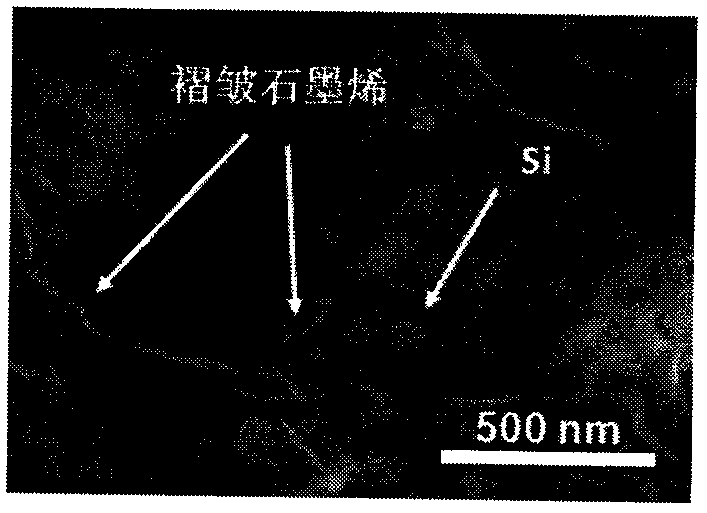Preparation method of silicon/folded graphene electrode material
A graphene electrode and graphene technology, applied in negative electrodes, battery electrodes, active material electrodes, etc., can solve the problems of complicated steps, waste, and time-consuming, and achieve easy control, low energy consumption, and low equipment requirements Effect
- Summary
- Abstract
- Description
- Claims
- Application Information
AI Technical Summary
Problems solved by technology
Method used
Image
Examples
Embodiment 1
[0023] (1) Add 1 g of silicon-aluminum alloy particles to an aqueous solution containing 1 g of graphene oxide, ultrasonically disperse for 1 h, and suction filter to form a composite film.
[0024] (2) When the film is not completely dry, add the film to a hydrochloric acid solution with a mass fraction of 10% for 2 hours.
[0025] (3) Take out the film and let it dry naturally.
[0026] (4) Heat the powder at a temperature of 70° C. for 4 hours.
[0027] (5) Put the film into a hydroiodic acid solution for reduction for 1 h, and wash it with ethanol to obtain a silicon / wrinkled graphene electrode material.
[0028] figure 1 A transmission electron microscope image of graphene oxide was prepared for this example.
[0029] figure 2 SEM image of the silicon / wrinkled graphene electrode material prepared for this example.
Embodiment 2
[0031] (1) Add 1 g of silicon-aluminum alloy particles to an aqueous solution containing 5 g of graphene oxide, ultrasonically disperse for 1 h, and suction filter to form a composite film.
[0032] (2) When the film is not completely dry, add the film to a hydrochloric acid solution with a mass fraction of 10% for 2 hours.
[0033] (3) Take out the film and let it dry naturally.
[0034] (4) Heat the powder at a temperature of 70° C. for 4 hours.
[0035] (5) Put the film into a hydroiodic acid solution for reduction for 1 h, and wash it with ethanol to obtain a silicon / wrinkled graphene electrode material.
Embodiment 3
[0037] (1) Add 1 g of silicon-aluminum alloy particles to an aqueous solution containing 1 g of graphene oxide, ultrasonically disperse for 1 h, and suction filter to form a composite film.
[0038] (2) When the film is not completely dry, add the film to a hydrochloric acid solution with a mass fraction of 10% for 6 hours.
[0039] (3) Take out the film and let it dry naturally.
[0040] (4) Heat the powder at a temperature of 70° C. for 4 hours.
[0041] (5) Put the film into a hydroiodic acid solution for reduction for 1 h, and wash it with ethanol to obtain a silicon / wrinkled graphene electrode material.
PUM
 Login to View More
Login to View More Abstract
Description
Claims
Application Information
 Login to View More
Login to View More - R&D
- Intellectual Property
- Life Sciences
- Materials
- Tech Scout
- Unparalleled Data Quality
- Higher Quality Content
- 60% Fewer Hallucinations
Browse by: Latest US Patents, China's latest patents, Technical Efficacy Thesaurus, Application Domain, Technology Topic, Popular Technical Reports.
© 2025 PatSnap. All rights reserved.Legal|Privacy policy|Modern Slavery Act Transparency Statement|Sitemap|About US| Contact US: help@patsnap.com


